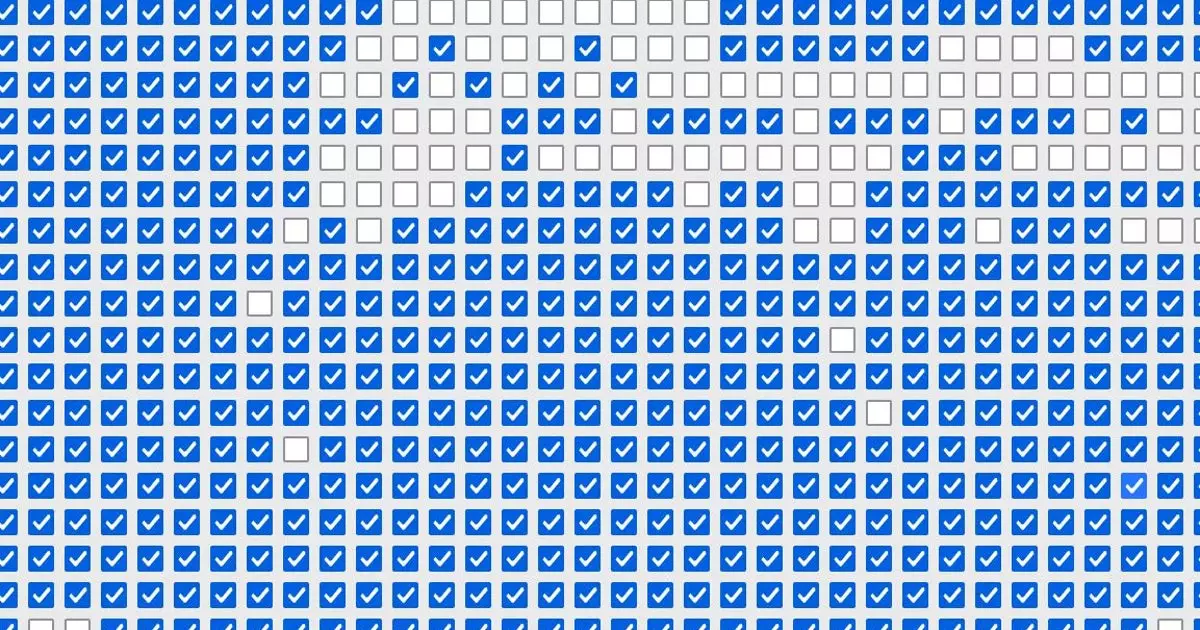In June, a striking phenomenon emerged on the internet that amalgamated creativity, competition, and digital art—One Million Checkboxes. Created by developer Nolen Royalty, this website invited participants to click through one million checkboxes, allowing users to leave their mark on the canvas of the internet collectively. What began as a simple click-based activity evolved into a captivating social experiment that attracted half a million visitors in just two weeks, resulting in an astonishing tally of 650 million box interactions. The sheer scale of user engagement speaks volumes about the digital community’s desire for both play and interaction.
The ostensibly straightforward game masked deeper layers of complexity, prompting participants to contend not merely for the act of clicking but also over the legacy of their contributions. Users engaged in a tug-of-war, checking boxes in efforts to fill in the canvas while also erasing the artistic endeavors of others. This behavior evokes a sense of camaraderie, rivalry, and, ultimately, digital artistry—encapsulating a new form of communal expression.
Royalty elucidated that participants discovered innovative methods for encoding messages within the checkboxes. The developer cleverly designed the interface so that messages only became legible at specific screen dimensions, thus preventing potentially offensive content from coalescing on the public forum. This precaution exemplified a forward-thinking approach to online interactions, adapting an otherwise chaotic environment into one that prioritized user experience and creativity.
Moreover, each checkbox functioned similarly to a binary bit—either checked (1) or unchecked (0). This foundational principle opened up avenues for players to write complex messages using basic binary code. During the website’s operation, Royalty executed backend changes to manage the flood of users. He whimsically opted to store the checkbox data in ASCII, a decision he candidly remarked upon without any clear motive.
However, this seemingly arbitrary choice manifested as a serendipitous revelation when he discovered URL links embedded within the ASCII text, leading him to panic at the thought of a possible security breach. This moment reveals a juxtaposition of excitement and fear, common in today’s digital age, where anonymity is often mistaken for malice. It turned out that rather than hacking, players were collaborating through calculated strategies—using bots to craft messages in binary code within the chaotic clickfest.
Royalty stumbled upon a community of sharp-minded teenagers congregating on Discord, which emerged as a playful hub for those engaged in the checkbox escapade. Here, users shared their findings, collaborated on innovative designs, and drafted messages that would ultimately contribute to the canvas. The initial camaraderie that had ignited among participants flourished into an associative network, drawing more individuals as days progressed. By the time the website closed, membership in this Discord channel had flourished from a mere fifteen to over sixty.
Their collaborative endeavors culminated in dynamic digital artwork that spanned iconic imagery and cultural references, showcasing a striking blue screen of death and even elaborate rickrolls. Upon his interactions with the Discord community, Royalty expressed deep appreciation for their creative spirit, reflecting on his childhood experiences with technology and mischief. The intelligent and artful expressions of the participants resonated with him as reflections of a playful, experimental internet that many long for in the current digital environment.
Nolen Royalty’s One Million Checkboxes represents more than just a quirky online game; it encapsulates a transformative moment in the landscape of digital interaction. While some observers expressed frustration over the presence of bots, the underlying thread of creativity and enthusiasm shared by the participants cannot be overlooked. The intersection of art, technology, and community during those two weeks serves as a reminder of the playful, yet profound, nature of digital artistry.
As Royalty concluded his experience, he framed the creativity exhibited by these young participants as a promising signal of the future. The “mischief-makers of today,” if nurtured, are set to become the innovators behind the games and experiences of tomorrow. In an era defined by rapid technological change, it is imperative to cultivate spaces where creativity can flourish, unearthing potential that extends well beyond the screen.
The resounding success of One Million Checkboxes may just be the beginning—a testament to the transformative power of play and collaboration in shaping not only digital landscapes but the nature of community itself. As the online realm continues to evolve, the spirit of this project can inspire future endeavors that celebrate creativity in ways yet to be imagined.


Leave a Reply